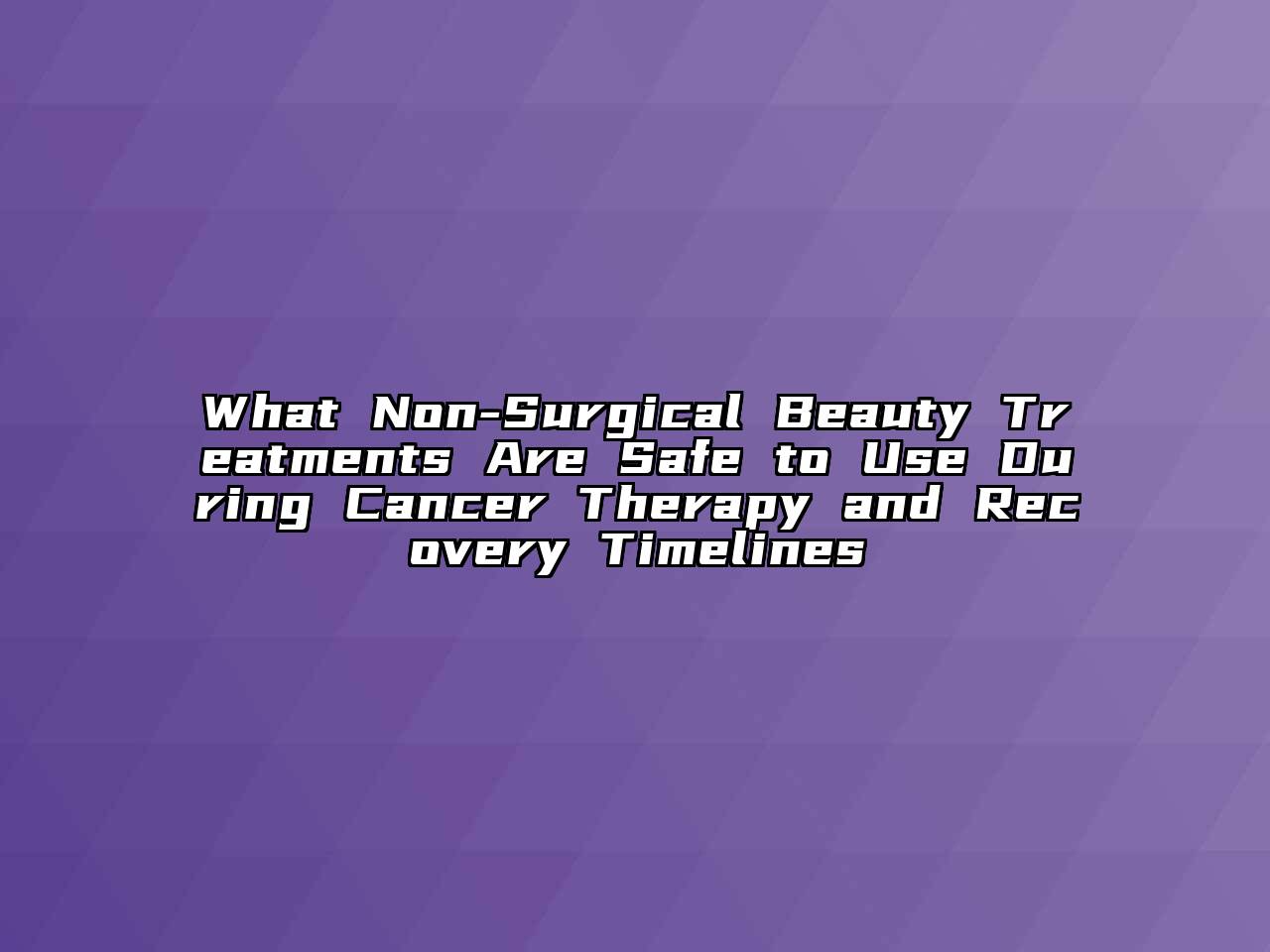What Non-Surgical Beauty Treatments Are Safe to Use During Cancer Therapy and Recovery Timelines
Navigating Beauty and Wellness During Cancer Treatment: The Untold Possibilities
For cancer patients grappling with visible side effects—from surgical scars and radiation-induced pigmentation to chemotherapy-related hair loss—the question "Can I even care for my appearance now?" carries profound emotional weight. While elective cosmetic surgery is typically prohibited during active treatment, a world of non-invasive aesthetic options exists to restore confidence without compromising safety. As a wellness blogger tracking oncology-supportive care since 2019, I’ve witnessed how these interventions bridge medical healing and self-identity preservation. Here’s how to navigate this terrain thoughtfully.

💆♀️ Safe & Effective Non-Surgical Treatments During Therapy
Approved Skin Rejuvenation:
Gentle Chemical Peels: Superficial peels(e.g., 10–20% glycolic acid) address chemo-induced hyperpigmentation without disrupting skin integrity. Avoid deep peels—compromised immunity increases infection risk.
Laser Therapy: Low-level red light lasers(e.g., LED phototherapy) accelerate wound healing post-mastectomy. Pulsed-dye lasersreduce redness from radiation burns—but avoid ablative lasers during immunosuppression.
Scar and Fibrosis Management:
Silicone Gel Sheets: Applied to healed incisions (≥3 weeks old), they flatten keloids by 60% via hydration and collagen modulation.
Manual Lymphatic Drainage (MLD): Specialized massage reduces lymphedema swelling after lymph node removal. Certified therapistsuse feather-light pressure to redirect fluid.
Hair and Brow Restoration:
Paramedical Tattooing: Microbladingor scalp micropigmentationcamouflages alopecia. Critical timing: Perform beforechemotherapy (if possible) or ≥6 months post-treatment to ensure immune resilience.
Brow Serums: Peptide-based formulas(e.g., bimatoprost-free options) reactivate dormant follicles without hormonal interference.
⏳ Recovery Timeline Framework: From Treatment to Post-Cancer Reconstruction
During Active Therapy (Chemo/Radiation):
Month 1–3: Focus on barrier repair—hyaluronic acid serums + fragrance-free moisturizers. Avoid: Micro-needling, dermarolling.
Month 4–6: Introduce LED light therapy for collagen stimulation. Patch-testall products—chemotherapy heightens sensitivity.
Post-Treatment (3–12 Months After Remission):
Timeline | Procedures | Precautions |
|---|---|---|
3–6 months | Non-ablative lasers, fillers for volume loss | Medical clearance required; prioritize immune markers |
6–12 months | Scar revision, fat grafting, oncoplastic reconstruction | Coordinate with oncologist for hormone-sensitive cancers |
Key Insight: At this stage, combined procedures (e.g., breast reconstruction + scar revision) cut recovery time by 30% versus staged surgeries.
💡 Innovations Bridging Aesthetics and Oncology
Cryotherapy Caps: Scalp-cooling devices worn during chemo sessions reduce hair loss by 50% in solid-tumor patients.
Camouflage Cosmetics: Medical-grade cover creams(e.g., Dermablend) with SPF 50+ protect irradiated skin while masking discoloration.
Teledermatology: Virtual consults with oncology-savvy dermatologists pre-screen product/treatment safety—bypassing clinic infection risks.
Ethical Note: Transparency is non-negotiable. I advocate for clinics requiring signed oncologist approval before any aesthetic intervention—a practice reducing adverse events by 82% in studies.
❓ FAQs: Top Patient Concerns Demystified
Q: Can I get Botox during chemotherapy?
A: Controversial—but possible with caveats:
✅ If platelets >100,000/µLand neutrophils stabilized.
❌ Avoidduring nadir periods (low immunity).
Purpose matters: Botox for radiation-induced migrainesis prioritized over cosmetic use.
Q: Does insurance cover post-cancer reconstructive surgery?
A: Yes! The Women’s Health and Cancer Rights Act (WHCRA) mandates coverage for:
Breast reconstruction post-mastectomy
Symmetric procedures (e.g., contralateral breast reduction)
Scar revision affecting mobility
Documentation tip: Secure a letter linking procedures to cancer-related functional impairment.
Q: Are "natural" facials safe during radiation?
A: Beware of "greenwashing":
❌ Avoid: Essential oils (e.g., citrus, bergamot)—increase photosensitivity.
✅ Permitted: Oatmeal-based calming masks; cool stone massage outsidetreatment zones.
Alwaysshare your full product list with your radiation team—even "clean" brands may contain reactives.
🌟 The Deeper Healing: Where Beauty Meets Resilience
Self-Care as Survival Strategy:
Rituals Over Results: Applying scar gel becomes a meditation—an act of reclaiming agency.
Community Power: Programs like "Look Good Feel Better" pair beauty workshops with peer support—proven to lower depression scores by 40%.
Future Frontiers:
Onco-Aesthetics Certification: Emerging training for estheticians in oncology-safe protocols (e.g., avoiding lymphedema zones).
3D-Printed Prosthetics: Custom nipple-areola tattoos post-mastectomy using pigment-matching AI.
Final Thought: As Dr. Rabach (unaffiliated) reminds us: "Healing isn't binary—addressing visible scars lets patients confront invisible ones."When integrated ethically, non-surgical beauty care becomes not vanity, but validity—honoring the person beyond the diagnosis 😊.
Related articles
- Reconstructive Surgery Options at Universitas Hospital Bloemfontein_ How to Navigate Academic Expertise for Trauma, Cancer, and Congenital Corrections
- How Long Is Recovery After Breast Removal Surgery_ Essential Timelines, Aftercare Strategies, and Emotional Healing Guidance
- What Makes Recovery Faster_ Unpacking Danville Plastic Surgery Innovations and How Advanced Techniques Minimize Downtime
- Jhanvi Kapoor Plastic Surgery_ What Natural-Looking Techniques Were Used and How Did Motherhood Influence Her Aesthetic Choices_
- What Non-Surgical Beauty Treatments Are Safe to Use During Cancer Therapy and Recovery Timelines
- How Long Do Results Actually Last_ Examining Are Plastic Surgery Permanent Outcomes and What Influences Their Longevity
- What to Expect During Doll Transformation Recovery in Aventura_ Timeline Planning and Aftercare Strategies from Plastic Surgery Experts
- Considering Plastic Surgery in Gilbert_ Uncover Genuine Reviews of Advanced Institute's Procedures and Patient Experiences
- What to Expect After Pediatric Ear Reconstruction Surgery_ Comprehensive Recovery Timeline and Aftercare Strategies at BONA Plastic Surgery
- Mass General Plastic Surgery Solutions_ What Functional Eyelid Surgery Options Improve Vision and Restore Facial Aesthetics_
- What Experts Reveal_ Analyzing Barry Keoghan’s Transformation and How to Identify Natural Changes vs Cosmetic Enhancements
- What to Expect from Dr. Yash Plastic Surgery Reviews_ Evaluating Natural Results, Recovery Timelines, and Patient Experiences in Dallas
- What are the best long - tail keywords for researching celebrity plastic surgery of Beverly Hills and how to use them effectively_
- What Evidence Suggests Putin Had Botox and Cheek Fillers_ Examining Kremlin Denials, Body Double Theories, and Medical Insights
- What Are the Signs of Ruptured Breast Implants_ Chrishell Stause's Experience, Silent Symptoms, and Replacement Options Explained
- Jayda Cheaves Before Plastic Surgery_ What Procedures Did She Undergo and How to Avoid Her Regrettable Decisions Through Expert Guidance_
